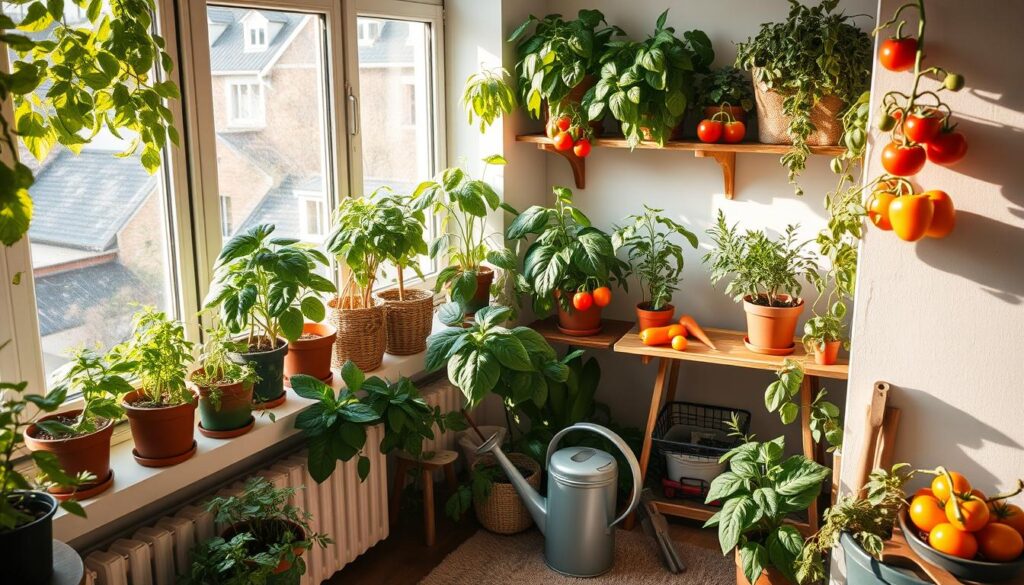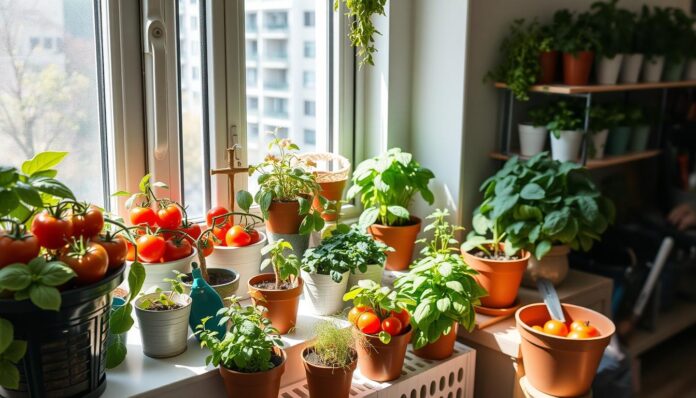Urban dwellers are finding joy in indoor apartment vegetable gardening. They turn small spaces into lively vegetable gardens. This way, apartment residents can grow fresh, healthy food without needing a big garden.
Indoor gardening brings more than just fresh veggies. City folks can enjoy homegrown food, better air, and a green living space. The trend of growing plants in apartments is growing. People want to connect with nature in the city.
Growing veggies indoors needs careful planning and special techniques. This guide will cover key methods for growing veggies indoors. It will tackle challenges of apartment gardening and offer solutions for city gardeners.
Indoor gardening requires attention to details like choosing the right containers and managing light and temperature. Beginners will learn to make the most of their small spaces. They’ll turn every inch of their living area into a green oasis.
Whether you have a sunny spot or a special corner, growing veggies indoors can be fun and rewarding. The next sections will guide you through setting up a thriving urban garden. You’ll learn how to grow delicious, fresh veggies all year.
Essential Requirements for Indoor Apartment Vegetable Gardening
To grow a successful indoor vegetable garden, you need to plan well. Apartment dwellers can turn small areas into green spaces. This is possible with the right growing space, lighting, and climate control.

Selecting Your Growing Space
Finding the right spot for your garden is key. Look for areas near windows or balconies with lots of natural light. Even small spaces like kitchen counters or windowsills can be great for growing vegetables with the right setup.
Mastering Light Requirements
Most veggies need 6-8 hours of direct sunlight a day. If you don’t get enough natural light, LED grow lights are a great solution. They give plants the full-spectrum light they need to grow well.
Temperature and Humidity Control
Keeping the right temperature is vital for your garden. Most veggies do best in temperatures between 65-75°F. Use small fans for air and consider using pebble trays or humidifiers to control humidity.
Understanding these key points helps apartment gardeners grow fresh veggies in small spaces.
Best Vegetables for Small-Space Indoor Growing

You don’t need a lot of space to grow veggies indoors. Even those living in apartments can have a garden. There are many small space crops and apartment-friendly plants to choose from. These compact varieties are great for small areas, bringing fresh produce right to your home.
Leafy greens like spinach and lettuce are perfect for indoor gardens. They grow fast, need little space, and give you a steady supply of greens. Herbs such as basil, mint, and cilantro also do well in containers near sunny windows.
Cherry tomatoes and small pepper varieties are great for indoor gardens. You can grow them in hanging baskets or vertical planters. This makes the most of your space. Microgreens are another good choice, offering lots of nutrients in a small area.
When picking veggies for indoor growing, think about how much light they need and the size of the containers. Some plants need lots of sunlight, while others do well in partial shade. Picking the right plants for your apartment’s conditions will help your garden thrive.
Pro Tip: Choose dwarf or determinate vegetable varieties specifically bred for container gardening.
Container Selection and Soil Preparation
Indoor container gardening turns small spaces into lively vegetable gardens. Choosing the right containers and soil mix is key for growing plants in apartments. The right containers help plants grow well and make the most of small indoor spaces.
Choosing the Perfect Growing Containers
Choosing the right containers is important for container gardening. You can pick from ceramic, plastic, or fabric containers, each with its own benefits. For big plants like tomatoes and peppers, choose pots that are at least 12 inches deep.
Smaller herbs can do well in 6-inch pots. Make sure your containers have holes for drainage to avoid root rot.
Crafting the Ideal Potting Soil
Good potting soil is essential for growing vegetables indoors. Gardeners suggest mixing peat moss, perlite, and organic compost for the best results. This mix helps keep nutrients and allows roots to breathe.
Don’t use regular garden soil. It can get too dense and stop plants from growing.
Implementing Effective Drainage Systems
Good drainage stops water from harming your plants. Place saucers under your containers to catch extra water. Adding a layer of gravel at the bottom of pots helps water flow better.
For those who are always busy, consider using self-draining containers. They have built-in systems to manage moisture.
Watering and Feeding Your Indoor Garden
Learning how to water your indoor garden is key. Each plant needs different amounts of water, based on its size, growth stage, and environment. It’s important to check the soil moisture before watering to avoid overwatering.
“Water is the lifeblood of your indoor garden – but too much or too little can spell disaster for your plants.” – Urban Gardening Experts
Feeding your plants the right way is also crucial. Knowing about fertilizers helps you give your plants the nutrients they need. Organic fertilizers like compost tea and worm castings are good because they release nutrients slowly and don’t have harmful chemicals.
Each vegetable needs different nutrients. Leafy greens need a lot of nitrogen, while tomatoes need phosphorus and potassium. Using balanced liquid fertilizers every two weeks can keep your plants healthy in small spaces.
Watering should be tailored to each plant’s needs. Herbs with shallow roots need more water but in smaller amounts. Larger plants need less water but more at a time. Using water at room temperature and making sure it drains well helps your plants grow strong roots.
Managing Pests and Plant Health in Indoor Gardens
Indoor vegetable gardens face special challenges with pests and diseases. Keeping your plants healthy means staying alert and using smart strategies. This helps prevent and fix indoor plant pest problems.
Pests like spider mites, aphids, and fungus gnats can quickly take over. They love the controlled spaces of apartment gardens. Spotting infestations early is key to managing diseases well.
Identifying Common Plant Diseases
Powdery mildew and root rot are big problems in indoor gardens. They happen when air doesn’t circulate well and there’s too much moisture. Look for white powdery spots or unusual color changes on leaves and stems.
Organic Pest Control Methods
“Prevention is always better than cure in indoor gardening” – Expert Gardeners
Organic pest control is a safer choice than chemicals. Neem oil and insecticidal soaps work well against pests. Adding beneficial insects like ladybugs can also control pests without harm.
Prevention Strategies
Having a strong prevention plan is essential for plant health. Quarantine new plants, keep humidity right, and ensure good air flow. Regular cleaning and checks can stop pests before they cause trouble.
Conclusion
Indoor gardening is a key part of sustainable living for city folks. It turns small spaces into green zones where you can grow your own food. These gardens are more than just places to grow veggies; they connect people to nature.
Indoor gardens offer many benefits. They improve the air we breathe, cut down on grocery bills, and boost our mental health. These compact gardens make it easy for anyone to grow food, even without a big backyard.
For beginners, indoor gardening is all about learning and growing. Start with a few plants, learn from each experience, and then add more. Online groups and local gardening experts are great resources for help and new ideas.
Indoor gardening is a smart choice for a greener future in cities. Every little garden helps reduce our impact on the planet. It shows our commitment to sustainability and strengthens our community.








